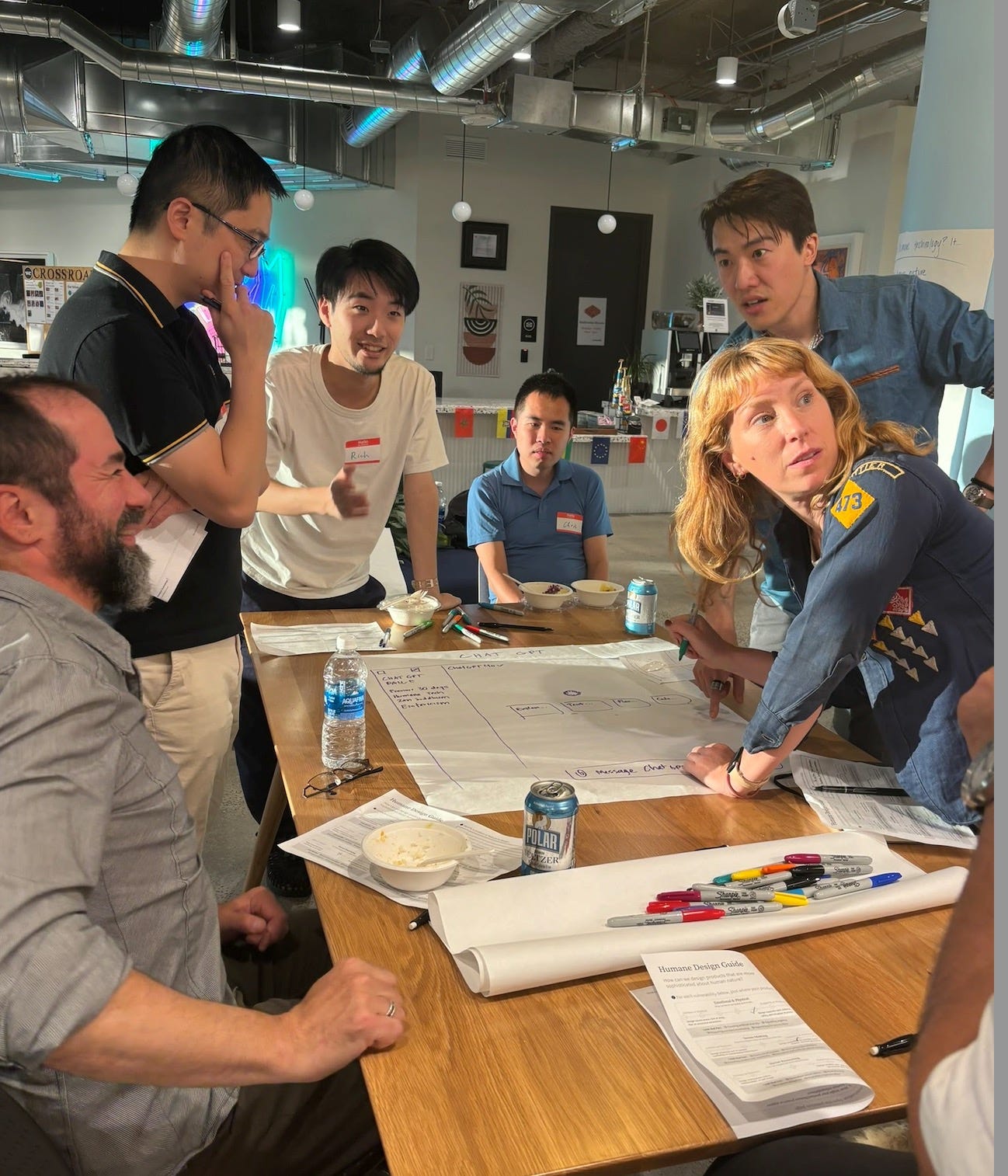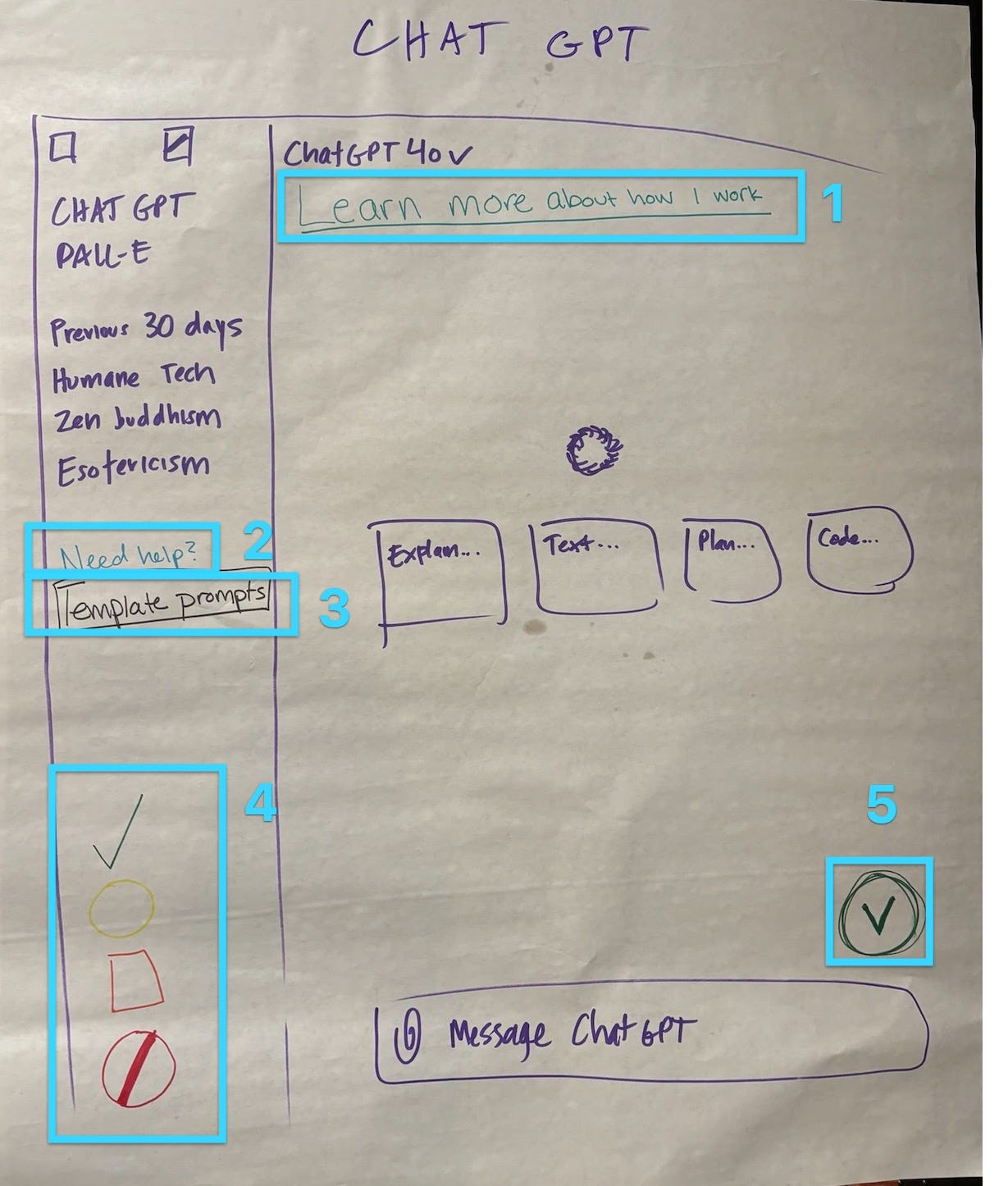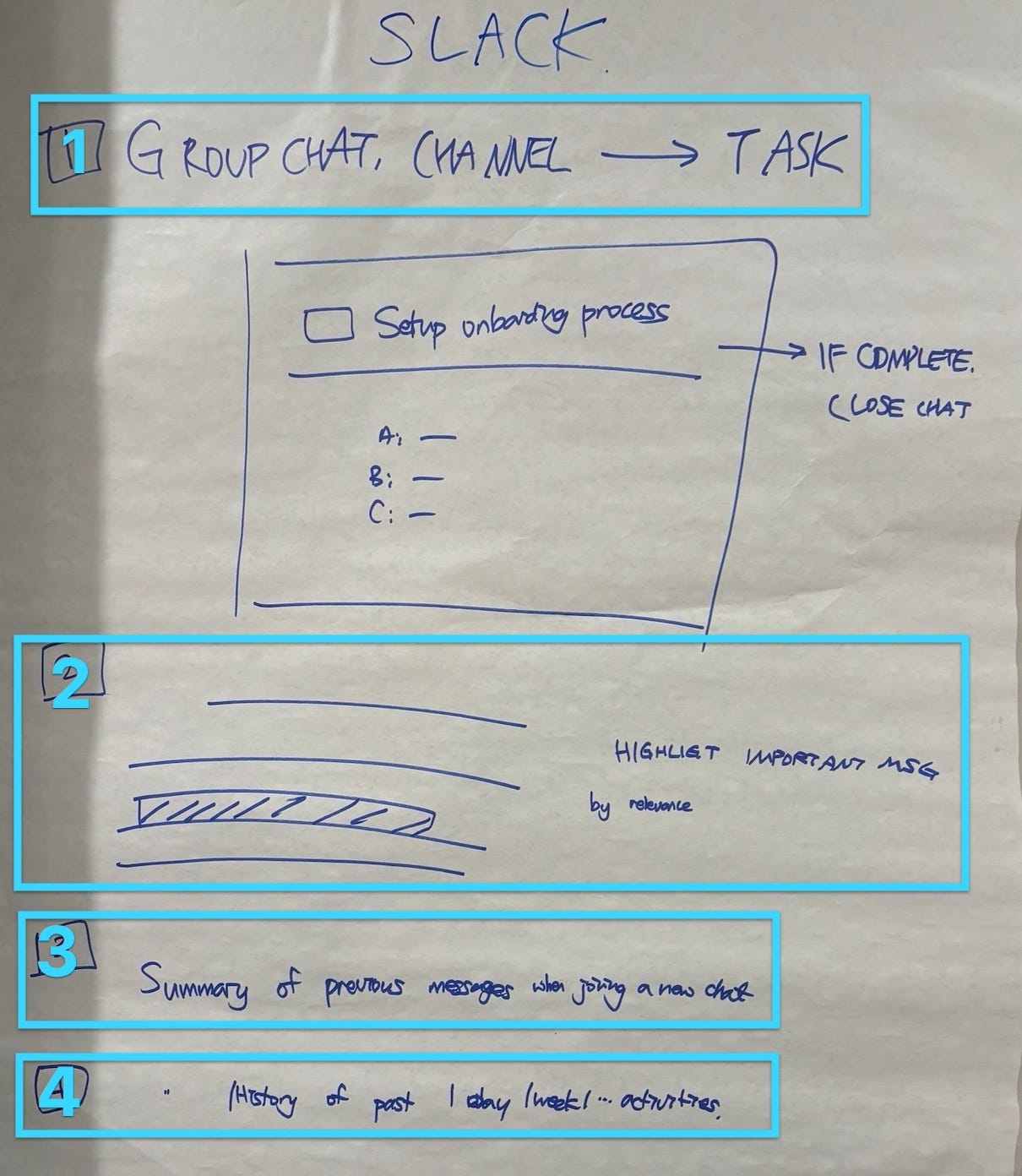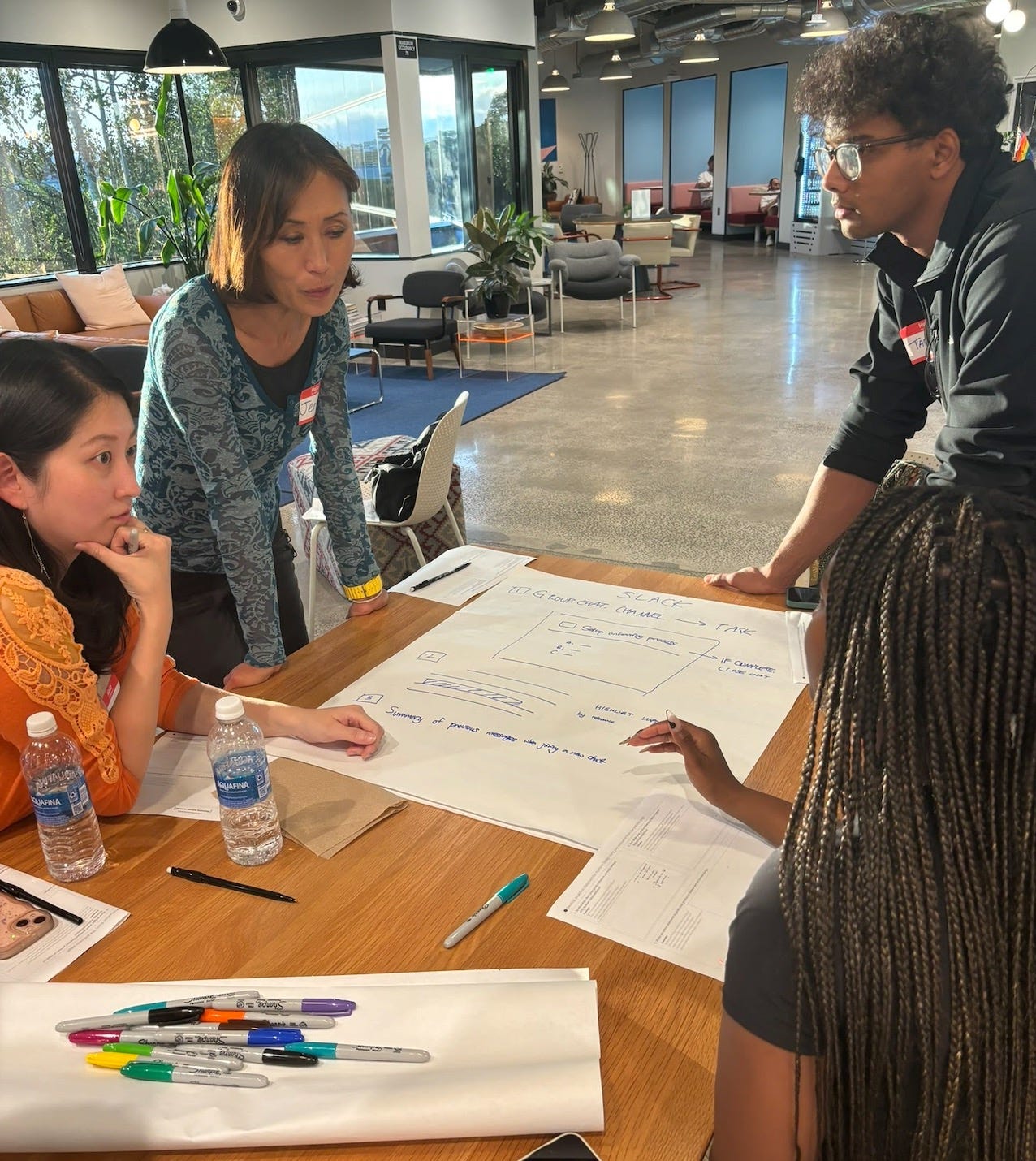Redesigning ChatGPT, Slack & X/Twitter to be more humane
Learn how to apply humane design principles to any product
Last time I asked you to forget everything. This time I’m asking you to create.
At our most recent humane tech meetup, instead of riffing on what a humane tech world could look like — an abstract exercise — we rebuilt it using humane design principles.
Well, to be clear, we rebuilt part of the world, focusing on these popular platforms: ChatGPT, Slack & X née Twitter.
What, you may ask, is humane design? At its base, it respects human nature, as opposed to taking advantage of it. For instance, evolution shaped our nervous system for vigilance, and guess what all those red notifications do? Like many others, when I see them on my phone, I hear alarm bells going off. Granted, some may be inured by now. But let’s get back on topic: the central tenets of humane design
minimize harmful consequences
avoid manipulative tactics that exploit users' attention and emotions
support well-being
foster calm, balance, focus, connection, and mindfulness
To apply these principles, download the Humane Tech Design Guide from the Foundations in Humane Technology course. For a more thorough definition, scroll all the way down on this post.
What if technology treated your attention and intention as sacred? - CHT
If you’re wondering how humane design relates to human-centered design (HCD), I see HCD as a method to better understand who you are serving as you architect from the ground up, be it a bridge or a mobile app, with humane design functioning either as a subset of HCD or in parallel, albeit solely focused on technology.
When we redesign according to humane design principles, what does tech become? It can connect us to ourselves and each other in authentic ways, become sustainable in the longterm, and thereby fulfill its promise. Note the contrast: in a world filled with get-rich schemes and the frenetic race to success, sustainability allows us to fulfill promises.
Lets step out even further: what is humane technology? It begins with this question: what if technology treated your attention and intention as sacred? Last week Wednesday, we decided to find out.
Between intros and rice bowls from Ricemill (thanks to UpHonest) our humane tech enthusiasts — a motley crew of founders, engineers, product managers, and advisors from design, venture capital, climate tech, and health care — had about 30 minutes to bring humane design to bear in these popular platforms. Everyone gravitated to whichever platform they wanted to change, and each individual kicked off their group session by evaluating the product according to the humane design guide. After some silent brainstorming, they brought their ideas to each other and started rebuilding.
Caveat: While design is a leverage point, there are far bigger levers to pull. Yet design still matters. If you need convincing, have a look at these deceptive design patterns, which highlight the importance of truth in advertising (and UX and UI).
While the former caveat was for your brain, this one is for your heart: in so many ways, we live in a world flavored by defeat. Belief systems abound, supported by what we see all around us: the individual is small, and the powers that be hold the keys — keys forever out of reach. In her book Thinking in Systems, Donella Meadows calls this system trap, “Drift to low performance.” For instance, when all we see is negative news, the world appears to be a tragic or even frightening place, when in fact plenty of good is happening, it just doesn’t get reported, because that’s not what news is built for.
So while achieving humane design may seen impossible, let’s remind ourselves of what was once impossible and now very much part of our world:
Smoking cigarettes in developed countries was not only acceptable but cool and ubiquitous. You couldn’t escape it. A popular brunch place in my hometown had a tiny island for non-smokers, surrounded by clouds of smoke. No one bat an eye. Now it’s banned in bars, restaurants, and workplaces around the world.
Growing up in Michigan in the 80s and 90s, I have zero memories of anyone coming out as gay in middle school or high school. Not publicly. Now most states have schools with a Gay Straight Alliance. Is it all schools? No? Do all LGBTQIA+ feel safe everywhere they go? No. But has the needle moved? Yes.
There are so many more examples, some being lived right now. So plunge into what’s possible and find a spark of hope. Let it become a song in your heart or a beat to march to that goes something like this: impossible-impossible-impossible done!
I want to recognize the challenge specific to humane design, which is that businesses optimize for profit. For better or for worse, we are intertwined with capitalism, and in that mode, the market always wins. As a business owner myself, I have to keep an eye to the bottom line. Otherwise everything I’ve built with my cofounder and employees is eroded.
Let’s be honest: does adopting humane design require a paradigm shift? Absolute yes. But that doesn’t mean it’s a fairytale. I don’t have all the answers but I commit to this journey of exploration — on my own, with others — which I’ll continue to share with you. With that, let’s dive in!
Starting point: We rebuilt ChatGPT’s simple design to give users more control.
Humane Design Principles Applied:
Sense-Making: Ensuring information is clear and verifiable.
Decision-Making: Enhancing user agency and understanding.
Features Implemented:
1: Educational Button: Adding a "Learn More" button to explain how AI works, demystifying the technology and making it less of a black box.
2: Help Center: Providing assistance to users who need a helping hand
3: Template Prompts: Providing template prompts to help users formulate better questions and reduce frustration.
4: Confidence Scale: Introducing color-coded responses to indicate the AI's confidence level, helping users gauge the reliability of the information.
5: Verification Button: Implementing a "Verify" button that allows users to fact-check and see the sources of the information provided, promoting transparency and trust.
Next up: We rebuilt Slack to help users catch their breath and reduce “noise.”
Humane Design Principles Applied:
Attention: Reducing frequent context-switching and undifferentiated choices.
Sense-Making: Providing clear, relevant information.
Decision-Making: Enabling agency and purpose.
Specific Changes Made:
1: Group Chat Management: Implementing a feature where group chats have a clear purpose and are closed once the task is complete, reducing unnecessary noise and clutter.
2: Message Highlighting: Introducing a system to highlight important parts of messages based on relevance to the team or individual, helping users focus on key information without sifting through long texts.
3: Summary for New Members: Providing a summary or main tasks overview for new members joining a group chat, ensuring they are up to speed without having to read through extensive message history.
4: Activity Summary: Adding a feature that offers a daily summary of activities, including what the user did and what they missed, to help them stay organized and focused.
We didn’t tackle the central issue of Slack, which is that it’s a supreme interrupter, dishing out FOMO right and left. That would likely require a complete overhaul. Think of these mocks as sprinters rushing out of the blocks on an Olympic track. We are far from the finish line.
Finally: We redesigned X/Twitter, focusing on choosing what you get to see.
Humane Design Principles Applied:
Attention: Allowing users to control their feed and reduce information overload.
Group Dynamics: Supporting community building and reducing divisiveness.
Notable Modifications:
1: Feed Customization: Adding buttons for users to select different types of feeds, such as connections-only, news, or local community updates, giving them control over what they see.
2: Bias Tracking: Incorporating a feature to track and display the bias level of news sources, helping users make informed decisions about the content they consume. (See Ground.news)
3: Time Management: Allowing users to set a timer for how long they want to spend on the platform, with the feed adjusting to provide a condensed version of content based on the selected time frame.
Did we solve for hate speech and misinformation on the platform? Not really. Though customizing your feed could help with that.
Is it too much to ask individual users how long they want to spend on each platform? Perhaps. What if social media apps automatically asked you every 10 minutes if you want to take a break? Sometimes I think we’re in the pre-sunscreen era, when it was “normal” to lay out all day, getting burnt to a crisp. A question we can ask ourselves: how do we apply sunscreen to tech?
Now for you: What will you design to foster a more supportive, transparent, and user-centric experience? How will you reduce information overload, enhance user control and understanding, and promote transparency and trust? It’s a long list. Start somewhere. At my startup, Storytell.ai, we’re sitting with these questions, too, which is why I’ll be leading a humane design session with our engineers this fall.
Where do we go from here?
Download the Humane Tech Design Guide and apply it
Use this prompt on any conversation about humane design principles:
Take module two of the Foundations for Humane Technology course
Learn humane design principles (see below) from the Center for Humane Technology
Join me at an event to explore these topics, whether in person or online
Come to our next Humane Tech meetup in the Bay Area
Join our Algorithmic Bias workshop with Alix Rübsaam
Attend our freethinking design webinar with Flavio Masson
Principles of Humane Design
from the Center for Humane Technology:
Emotional & Physical: What we feel in our bodies and minds.
Look Out For: ⓧ Creating artificial scarcity ⓧ Signaling urgency ⓧ Requiring constant monitoring ⓧ Optimizing for screen-time
Inhumane Design causes stress, lack of sleep, fear, or emotional exhaustion.
Humane Design supports calm, balance, safety, and circadian rhythms.
Attention: How and where we focus our energy
Look Out For: ⓧ Frequent context-switching ⓧ Undifferentiated choices ⓧ No stopping cues (ie: infinite scroll) ⓧ Unnecessary movement
Inhumane Design draws, fragments, or overwhelms attention.
Humane Design enables more focus and mindfulness.
Sense-Making: How we integrate what we perceive and know.
Look Out For: ⓧ Facts out of context ⓧ Over-personalized filters ⓧ Equating virality with credibility ⓧ Deceptive authority (ie: ads vs content)
Inhumane Design promotes out of context, confusing, or manipulative information.
Humane Design enables us to consider, learn, express, and feel grounded.
Decision-Making: How we align our intentions and actions.
Look Out For: ⓧ Avatars to convey authority ⓧ Stalking ads and messages ⓧ Push content modules ⓧ Serving preference over intent
Inhumane Design manipulates behavior and independent choice.
Humane Design enables agency, purpose, and mobilization of intent.
Group Dynamics: How we interact with society and groups.
Look Out For: ⓧ Suppressing context and nuance ⓧ Enabling hate speech ⓧ Enabling viral outrage ⓧ Lack of agreed-upon norms
Inhumane Design excludes, divides, or mobilizes through fear.
Humane Design develops a sense of belonging and cooperation.
Social Reasoning: How we navigate personal relationships.
Look Out For: ⓧ Quantified social status ⓧ Viral sharing ⓧ Implied obligation ⓧ Enabling impersonation
Inhumane Design manipulates status, relationships, or self-image.
Humane Design enables safe, authentic connection with others.
How did I create this post?
I recorded the meetup using Otter.ai, informing all participants we’d be respecting Chatham House Rule
I contemplated and deliberated. I debated with my co-founder.
For my reflection on the platform redesign, I created this prompt and used it on the Otter recording in Storytell







Bravo, Erika! Love how you've grounded those high-flying humane design ideals in real-world platforms. Your redesigns are a wake-up call – reminding us that these interfaces are human creations, not forces of nature. You're opening our eyes to what's possible when we put users first.